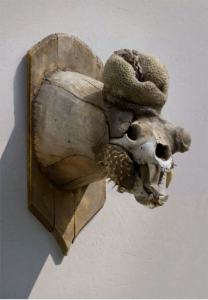Forget Dickens’ “It was the best of times, it was the worst of times,” or Austen’s “It is a truth universally acknowledged,” my favourite opening line has to be from Dennis Todd’s book, Imagining Monsters (1995): “Sometime in October 1726, Mary Toft, the illiterate wife of a poor journeyman cloth-worker, gave birth, in Godalming, Surrey, to her first rabbit” (1). This is surpassed only by the following line, which reads “She went on the deliver sixteen more” (1). Todd’s book documents the extraordinary lengths Toft went to to persuade her local surgeon that she was indeed giving birth to rabbits, a series of acts that were so convincing that she was eventually moved to London so that the king’s surgeon could also witness these miraculous births.
It took over a month for her performances to be revealed as a hoax (Todd 2), but, for a modern audience, that she could fool so many people for so long seems utterly ridiculous. As Todd writes, however, “[t]hose who perpetrated the hoax may have been knaves, but those who were taken in by it were not fools” (39), and he points out that the reason Toft’s charade was successful to begin with was because of an ancient understanding of gestational development.
Many, many feminist writers have demonstrated the mistrust patriarchal systems have for women’s ability to reproduce and the subsequent attempts to control and regulate women’s bodies before, during, and after pregnancy. In fact, many existing regulations regarding what a woman imbibes during pregnancy are direct vestiges of Early Modern beliefs surrounding the invisible creation of the child in utero. What has always struck me about narratives espousing these beliefs is how the threat of monstrosity is used to underline the author’s fears for the foetus, with little to no consideration of the mother – apart, of course, from the continued regulation of her body and her behaviour.
One of the most pervasive beliefs regarding the formation of the child during pregnancy was that of maternal imprinting, a belief that pre-dated Aristotle and that persisted well into the nineteenth-century. Maternal imprinting is the notion that a woman’s thoughts, specifically her fears and desires, will somehow directly affect the physical appearance of the child she carries. Rebecca Kukla offers an explanation for this belief:
Passions and appetites inhabited an interesting border territory between the realm of the mental and meaningful and the realm of the bodily and brutally causal . . . Passions, despite their meaningful content, traded in and operated through somatic urges and responses rather than the cold, dispassionate light of reason. Thus the passions provided the perfect medium for meanings to translate themselves from the world onto bodies. Women’s pregnant bodies, with their weaker resistance to passions and their intense cravings, their higher impressionability, and the fragile or nonexistent boundaries separating them from their fetuses, were in turn ‘natural’ sites for such passionate transmissions (Kukla 17).
Toft’s case is a perfect ratification of Kukla’s argument, as the cause she put forward for her multiple rabbit births rested on both fear and desire: “Mary Toft would claim in April, when five weeks pregnant, she had been weeding a field and was startled by a rabbit. She and the woman she was working with ran after it but could not catch it. The chase made her long for rabbits” (Todd 7). Todd indicates that it was this narrative – being both startled by a rabbit and thence developing a craving for rabbit meat – that eventually persuaded Toft’s local surgeon, John Howard, of her veracity (8).
Kukla explains that the belief in maternal imprinting was so widely held onto because of an ancient understanding of the womb as permeable and susceptible to corrupting influences, an understanding that would transfer to the pregnant body itself (Kukla 5). She also notes that even more so than being prone to corruption, the womb itself was seen as a corrupting influence, as it was at the root of untoward cravings, the “seat of capricious and forceful appetites that beckon foreign substances in,” thereby threatening the development of the foetus (6). What is more, writes Kukla, “[t]he whole notion of a craving – so deeply linked in our imagination with pregnancy – is of not just any appetite but an appetite that is inherently irrational, unpredictable, forceful, and hard to control or deny” (6).
The passionate craving Mary Toft had for rabbit meat, coupled with the fright she experienced while out weeding, went a long way to giving a contemporaneous explanation for her production of rabbits. However, Todd points out that Toft’s performances didn’t only rest on an eighteenth-century understanding of foetal development but on the fact that she had recently suffered a miscarriage and was therefore sporting very visible signs of pregnancy:
probably most persuasive was the entire mise-en-scène of pregnancy, labor, and birth that Mary Toft staged. Some of the effects were real enough. Her miscarriage had left her with signs of pregnancy. Often she bled, and often her pain was unpretended. What was not real, she could act, and her most impressive performances were enhanced by her ability to set off powerful, pulsating contractions in her abdomen, contractions lasting for hours at a time (8).
Todd also believes that it was precisely because Toft cited so many reasons for imprinting that many doubted her story: “Perhaps the fact that she fashioned her account to include all three provocations to the imagination – a surprise, an obsessive dwelling on an object, and an unsatisfied longing – should have made more people suspect that she was overreaching” (52). What is more, even if it was the most widely accepted cause of monstrous birth, maternal imprinting was not in fact the only accepted origin of abnormal births: from the Middle Ages onward, respected scholars across Europe gave various reasons for monstrous birth and, while imagination was included in this litany of causes, it was certainly not considered the most common (48). By the 1720s, however, maternal imprinting was the most cited cause of monstrous birth, a fact that didn’t escape the notice of Toft’s critics.
Furthermore, birth defects in the Middle Ages and the Renaissance were attributed to maternal imprinting because these defects resembled other objects from the natural world. Thus,when a child was born with a hare lip, its cause was accredited to maternal fears and desires, or to the mother’s physical closeness to a pet. Todd points out that part of what made Toft such a sensation, as well as aiding her downfall, was that she didn’t give birth to offspring that resembled rabbits, but that these births were of actual rabbits and rabbit pieces (52).
Todd explains that the plan was to originally fabricate a “monster” from the body of a cat and the leftovers of an eel dinner, but that Howard remained unconvinced by the “birth” until he saw a head. The cat’s head being lost, Toft and her husband use the head of a rabbit, which she passed the next day (6). Why on earth would Toft (and her husband and mother-in-law) go to so much trouble to concoct such a seemingly daft plan? Toft’s confession indicates that all three conspirators were motivated by money (Todd 4), where her “monsters” could be exhibited for a fee.
After being pressured into confessing her lie, Toft was imprisoned in Bridewell for a time before being sent back to Godalming, where she lived out the rest of her days. Reading Todd’s documentation of these events once again (I spent much of my PhD thesis writing about monstrous birth), I’m horrified by the number of people that Toft was examined by. Not only does Todd list her local surgeon, John Howard, and the Royal Surgeon, Nathanael St. André, as having physically examined Mary Toft in a very intimate manner, but all manner of scientists, scholars, and surgeons from London are quoted as probing Toft vaginally in order to prove that the rabbits were coming from her uterus. Of course, whether or not Toft consented to all these examinations we’ll never know, as it was never the prerogative of the medico-scientific gaze to document patients’ (especially women’s) experience as objects of this gaze.
References:
Kukla, Rebecca. Mass Hysteria: Medicine, Culture, and Mothers’ Bodies. Lanhalm, US: Rowman and Littlefield, 2005. Print.
Todd, Dennis. Imagining Monsters: Miscreations of the Self in Eighteenth-Century England. Chicago: U of Chicago P, 1995. Print.









